John Dennett
John Dennett
During the winter of 1941 John worked as an apprentice bricklayer with his father; constructing accommodation blocks for the Royal Navy at Corsham Wiltshire. It was local work to the village of Shaw in Wiltshire where John was brought up.
My mate and I joined the local Home Guard, we had a bit of fun being soldiers in our spare time. I could have claimed reserved occupation, that winter gave us the idea of joining up. We wanted to be part of what was going on in the big world and it seemed exciting.
Mum was refusing to give me my birth certificate just said, ‘You can’t go’ and that was that. Dad on the other hand was happy with the idea; he said it would do me good. So, I went off to Bristol and joined the Navy I didn’t have my birth certificate, so I added 6 months to my age to get me over 18. Nobody asked for my birth certificate, they would have turned me away on account of being underage if my mum had given it to me.
John joined the Royal Navy at the age of 17 in March 1942 and was sent to Devonport for basic training, then onto Gunnery School for training as an anti-aircraft gunner. John’s first active service came in November with a rail ticket to Scotland where he boarded RMS Queen Elizabeth in Loch Ewe in the far North West of Scotland. It was a deep-water sea loch which was ideal for the assembling convoys. John, was destined for the United States, making the trans-Atlantic voyage aboard one of the fastest ships afloat, which had been refitted in Singapore for service as a troop ship. Like its sister ship, the Queen Mary, both liners could operate without military escort and relied upon their ability to maintain a constant speed of around 30 knots. The Queen Elizabeth ferried American troops mainly from New York into Gourock on the River Clyde. The return crossings were used to take Royal Navy crews over to the US dockyards to collect the increasing quantity of ships built under the Lend-Lease scheme.
Landing in Halifax Nova Scotia John and his fellow crew members travelled by rail across Canada through Quebec & Montreal down to the British establishment of HMS Astbury in New York. HMS Astbury was in fact two hotels used for Royal Navy personnel.
It was quite an adventure coming over from Scotland, we then realised that we would be in New York for Christmas. The Americans treated us so very well after the shortages and black outs back home it was a great Christmas. Each of us was matched with a local family for the holiday season: we were all at the Newark Railway Station and as each name was called out, we were then introduced to our family for the duration. We absolutely could not fault the welcome we were given.
In January. John and the crew moved into the US Naval Base to begin training as LST 322 was put into the water ready for commissioning. ‘Even now I remember how fantastic the food was’ says John. LST standing for Landing Ship Tank, these vessels were designed to carry heavy military equipment, vehicles and tanks. With side opening doors at the bow and a flat-bottomed hull, despite its size and fully loaded displacement of 3,880 tons the LST could offload directly onto the beaches. LST 322 (shown above) had been built at the Philadelphia Navy Yard.
Destined for Gibraltar in support of the landings in North Africa, after working up and sea trials, LST 322 set off within a much larger convoy, codenamed Operation Torch. The crossing took about three weeks with the convoy consisting of a mix of tankers, freighters and troop carriers.
The flat bottom was not suited to the deep sea, so it certainly wasn’t a comfortable crossing. The convoy was routed into Gibraltar but went straight onto Algiers and Oran. Along with other equipment, LST 322 was loaded with smaller landing craft which were needed. Once offloaded, they were given a bit of shore leave.
Operating in support of Monty’s 8th Army we worked our way along to Tripoli. The 8th were getting the best of the battle against Rommel’s Afrika Corps by this time; but we were certainly kept busy. Malta was a key part of the supply line and we ferried petrol, provisions and equipment there quite often. Often under air attack we took a few hits but nothing serious. It was LST 429 which ran out of luck, sunk just off the coast of Libya in July.
John took part in the Sicily landings codenamed Operation Husky. Weather conditions were not at all good, which helped keep an element of surprise for the landings. By this time LST 322 was part of the 3rd Flotilla, landing on the south east coast of the island roughly between Licata Torre di Gaffe and Mollarella beach. The largest amphibious operation of the war to date in terms of the number of divisions landed on the first day, 10th July 1943.
The landings supported by four battleships, four aircraft carriers, along with a variety of other smaller ships. The British 8th Army including the 1st Canadian Division under Montgomery struck out from the east whilst the US 7th Army under Lieutenant General George Patton moved from their landings in the west, both striving to reach Catania and the Messina Straights. The taking of Sicily coincided with a coup which removed Duce Mussolini, urging the Allies into a quick continuation onto the Italian mainland. Planning for the next assault was rushed, combining an 8th Army crossing of the straights into Calabria followed swiftly by the seaborne landings at Salerno codenamed Operation Avalanche which took place from 9th September. The drive north from Messina was largely unopposed but occupying forces took advantage of the geography. The Salerno landings were fiercely opposed, calling for massive naval support.
LST 322 was in the thick of the action, taking part in the transport and landing of the British X Corps and US VI Corp, both under the American Lt. Get. Clark’s US 5th Army. Salerno Bay had a wide beach of approximately 20 miles but this time the enemy was expecting the landings and was fully prepared.
The landings at Salerno were made under heavy fire from shore-based guns and the usual air attacks, but we managed to beach and unload, then departed for another load, this time from Palermo in Sicily. Also waiting for us was our first mail since America. We also continued to load at Tripoli, to move stores to Italian ports; such as Taranto. The Italian fleet had just surrendered, and it was interesting to see these warships up close but out of action.
Marshal Badoglio announced on the radio that The Italian Government, recognizing the futility of continuing the uneven struggle against overwhelming enemy power, and with the intent of saving further and more serious calamities to the Nation, asked Gen. Eisenhower, CinC of the Allies forces, for an armistice. on 8th September the request was been accepted this action led to the surrender of the Italian Fleet. this coincided with the Salerno Landings. The following day, the Italian Fleet sailed from La Spezia for Valetta although one of the battleships was sunk during a German air attack. They were then escorted into Valetta Grand Harbour by HMS Warspite & HMS Valiant, a signal sent by Admiral Cunningham on the 11th: “Be pleased to inform Their Lordships that the Italian battle fleet now lies at anchor under the guns of the fortress of Malta.”
The two battleships were despatched back to Blighty but were urgently re-directed to Salerno as the situation there had deteriorated. Between the 12th to 14th September the Germans had unleashed a concerted counterattack deploying six divisions against the Salerno beachhead with the objective of driving the Allies back into the sea before they could link up with the British 8th Army advancing from Calabria. The defending forces drove a salient between the two American divisions where the Sele and Calore rivers merged. Allied troops were too thinly spread to resist these attacks, so the battleships were desperately needed to redress the situation.
The descriptions of the Salerno Landings give an idea of the situation faced by John and the LSTs running back and forth in support of the landings. As well as the ground action, there were continuing heavy air attacks by Focke Wulf 190 fighter bombers and Dornier 217 heavy bombers. On the afternoon of 14th it was a Dornier-217 bomber which released a cluster of three glider bombs aimed at HMS Warspite, two of these were on target. HMS Warspite was hit and suffered casualties but limped back to Malta, then on to Gibraltar and finally to Rosyth. The foothold eventually gained from Operation Avalanche was inconclusive, so another landing was planned further north in order to outflank the Germans ahead of their Winter Line. With deadlock at Monte Cassino this could allow a faster advance on Rome. Codenamed Operation Shingle under command of American General John Lucas. The landings started in the early hours of 22nd January 1944 on a fifteen miles wide stretch of beach near the holiday towns of Anzio & Nettuno.
These landings were entirely unexpected so unopposed, with all British and American objectives successfully being taken by noon on the first day. Although the enemy didn’t have ground troops, beaching was carried out under heavy shelling and air raids by bombers. Luckily, we survived to carry on back to Naples for another load, this continued for the next few weeks. Each time running the gauntlet of ‘Anzio Annie’ – two 12″ guns on a railway track, which attacked all the convoys of LSTs – and being harassed by air attacks. Some LSTs were lost and the hospital ship St David was sunk.
For the assault troops the second day saw an easy penetration up to four miles inland. Some reports suggest it was sunny and quite warm for the time of year, and hard to believe there was a war at all. Anzio was just 30 miles south of Rome and 55 miles north of the main line of resistance. It seemed there was a clear run to Rome, historians generally agree that General Lucas was overly cautious and spent too long securing his bridgehead; giving the defending forces time to recover and build new defences. As a result of the lack of offensive vigour, the following four months saw some of the most savage fighting of the War.
Allied forces engaged in the Anzio attack consisted of five cruisers, 24 destroyers, 238 landing craft, 60+ other ships, 40,000 troops and 5,000 vehicles. Although the main worry was a shortage of supplies, this never reached a point of serious concern. When the main Force was ashore, six LSTs left Naples every day each carrying 1,500 tons of cargo loaded on 50 lorries. Once ashore, these vehicles moved directly inland and returned to the same LSTs empty for return to Naples. Supported by other smaller craft as well as four Liberty ships, between February and May over 530,000 tons of supplies were delivered to the Anzio beachhead, a daily average of 3,920 tons.
With Allied resources stretched, as soon as the situation at Anzio could manage, ten LSTs were released and sent back to England to be available for the Second Front invasion of France. LST 322 was part of this flotilla and John was pleased to be on his way home, arriving in Liverpool on 4th April. John remembers that two LSTs separated to Tilbury, two to Swansea, two to Liverpool and thinks the remaining four went on to Glasgow. It was necessary to have these vessels in dry dock for repair and maintenance after so long in the water and such consistent action.
It was great to be back, even if Liverpool was not my hometown. Of course, everywhere was a hive of activity. We had an extended shore leave whilst the work was being carried out. This gave me the opportunity to be out and about around the city in fact this is when I met Joyce, my wife to be. It is also how I came to remain in the Merseyside area.
As soon as it was ready, LST 322 departed Liverpool for Portsmouth. By late May the vessel was loaded ready, waiting for the final decision to make the crossing.
We didn’t know too much about what was going on. I suppose we knew more than the troops but it was just a question of waiting for that final decision so we could make a start. To clear dockside space we were moved out into the Solent but it was late on 5th June that we set off properly so we could get into position off the French coast.
Passing close to HMS Warspite as she opened up with her heavy guns. We hadn’t seen her since Salerno and knew her affectionately as the Old Lady. Even with one turret still out of action the first broadside made it seem like the she had taken a hit. The whole ship rocked backwards in recoil, with a great belch of flame before being covered in smoke. It was such a fantastic sight. We went into Sword Beach to offload troops and heavy equipment, returning promptly to Portsmouth.
I think we made a dozen or so crossings in all. On the return journeys we would be loaded up with injured troops and prisoners.
John and his crew mates on LST 322 made a further 15 crossings, picking up troops, tanks and vehicles at Portsmouth, Southampton and Tilbury. This went on into August 1944.
I had a chance for promotion, to go on a higher gunnery course, so I took some leave. Then they transferred me to the aircraft carrier, HMS Patroller. Originally an American ship, it had been transferred to the Royal Navy towards the end of 1943 and was used for the duration on convoy protection duties on the Atlantic crossings.
By August 1945 we were in Glasgow being made ready for use in Burma. I was transferred South Shields to join a minesweeper. We were tasked to take part in the efforts to clear the Irish Sea and Western Approaches. I was on this until May 1946 and took a release; there was a degree of priority for those who could return to a reserved occupation although that meant I had to lose three weeks pay. It occurred to me then that I could have claimed reserved occupation all the way through and avoided all those beach landings. On reflection, I wouldn’t have missed it for the world! We all felt like it was a great adventure; we were young and fit and a bit daft and happy to serve. I am sure the youngsters would do the same today.
This personal history of John Dennett’s war service is a history of the Royal Navy’s supported seaborne landings throughout the war. All main landings are included Torch in North Africa, Sicily, Salerno, Anzio… then the big one in Normandy. He didn’t miss much!
So, what does John think of it all now, looking back over so many years?
I have been back to Normandy every June for the last five years. Traveling in a group of 50 or so veterans it has been a terrific experience. I enjoy meeting the local French people and we have done a few school visits. I am so happy to receive the warm welcome from the French people because we know they had a very tough time from occupation, then invasion. I particularly like to pay my respects at the Landing Craft Association memorial at Ouistreham and make sure I go there each time.
I recently went over to Italy with the Italy Star Association. I was there for about a week visiting all the main sites that I remember well. Even so, I didn’t realise quite how many men we lost once they moved off the beach landing areas. For all those, and the ones we lost in Normandy, it is important to remember and to make sure the kids today understand what was done for them. I enjoy school visits near my home in Wallasey and sometimes we get over to a school in North Wales. I get a real kick from talking with the children. It is important they know what happened, and they ask what it was like and if we were frightened. The children are always full of questions, sometimes a bit bloodthirsty and they lose interest if you say you haven’t shot anyone! But they also want to know the basics: what did we get to eat and where did we sleep? They even ask what my Mum had to say about it all!
John agreed to become the Associations National President in September 2019 taking on the role after the death of Bryan Woolnough

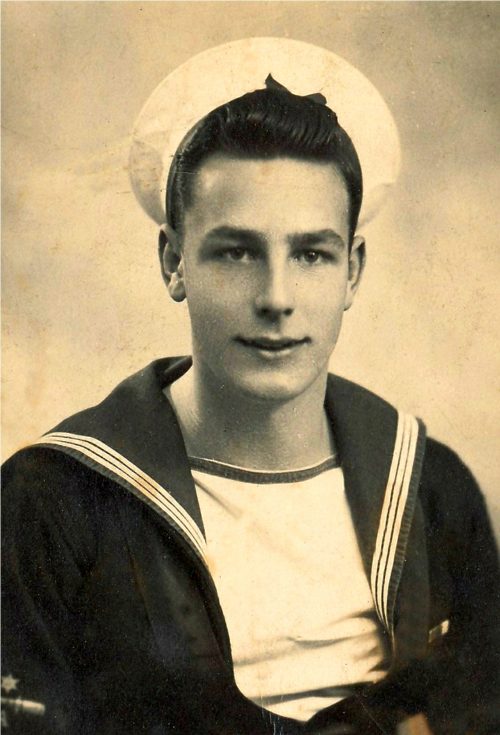
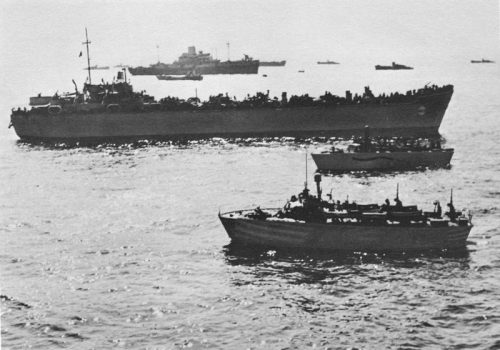
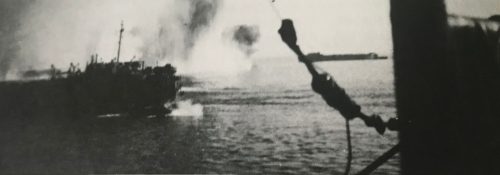

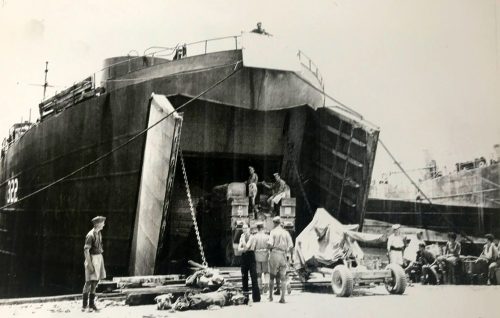
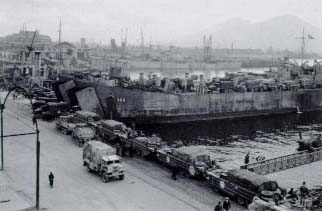
Dear John,
I recently read your post and if you are agreeable I would like to use your story and photos in my book ‘Forgotten Heroes’, a non-fiction illustrated book based on the Italian campaign.
The idea for the book – for veterans and families to share their stories by letters, maps, diaries, diagrams and photos. If you can help I would be grateful.
Sandra Doran
Sandra,
Did you ever get a reply to your Question?
John is Family so I could forward your request.
Yours,
Duncan LAW
Dear John
I am the grandson of Francis (Frank) Anness Bishop who I understand served as a Sub-lieutenant on LST 322 during the D-Day landings. I am curious if you have any recollection of serving with my grandfather or remember him in any way. Frank was tall 6″3′ and a kiwi – he married a Plymouth Lass during the war and brought her and my father back to New Zealand at the end of the war.
Kind Regards – Richard Bishop
Richard – did you ever get a reply to your Question?
Uncle John is Family, I can ask him ASAP.
Yours,
Duncan LAW
Hi Duncan – I just saw your reply now – I didn’t get anything back so if you can help that would be great. Regards, Richard Bishop